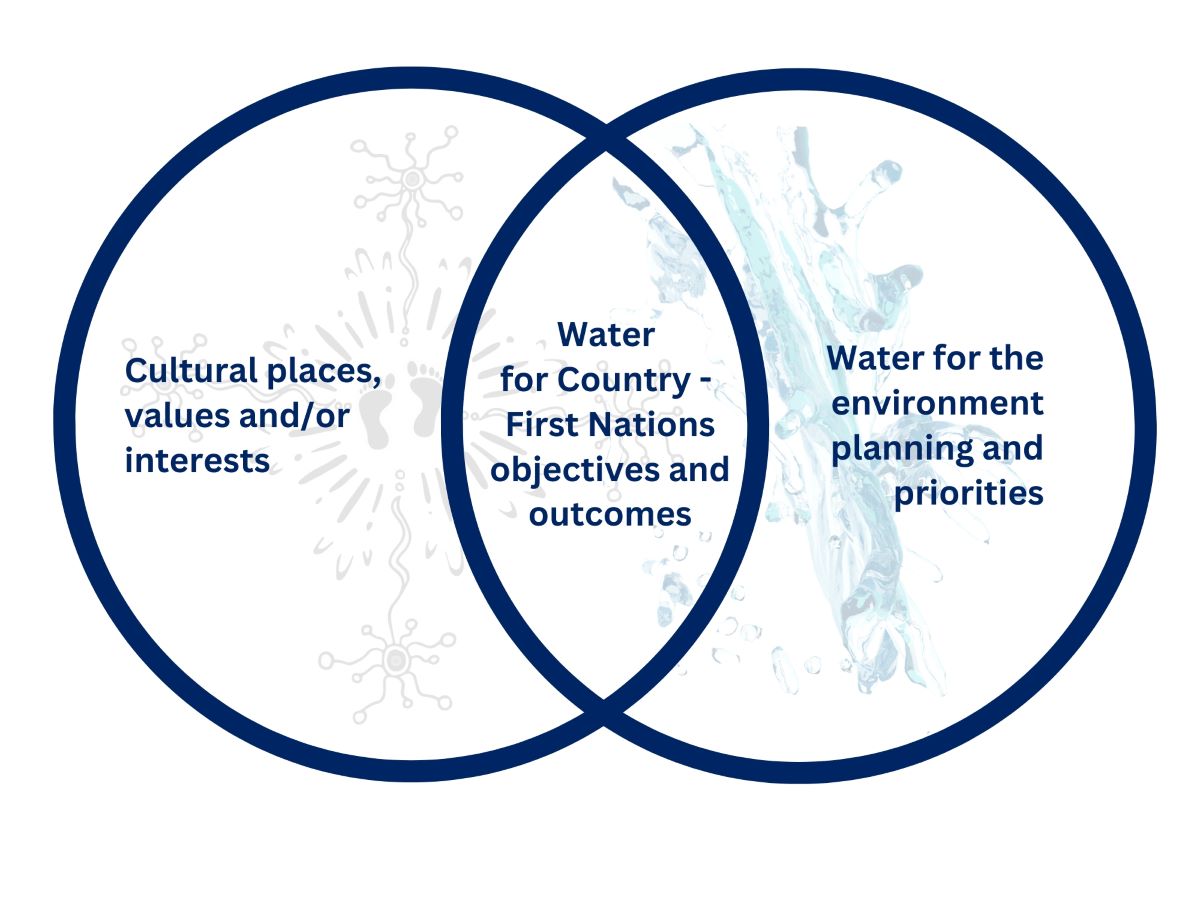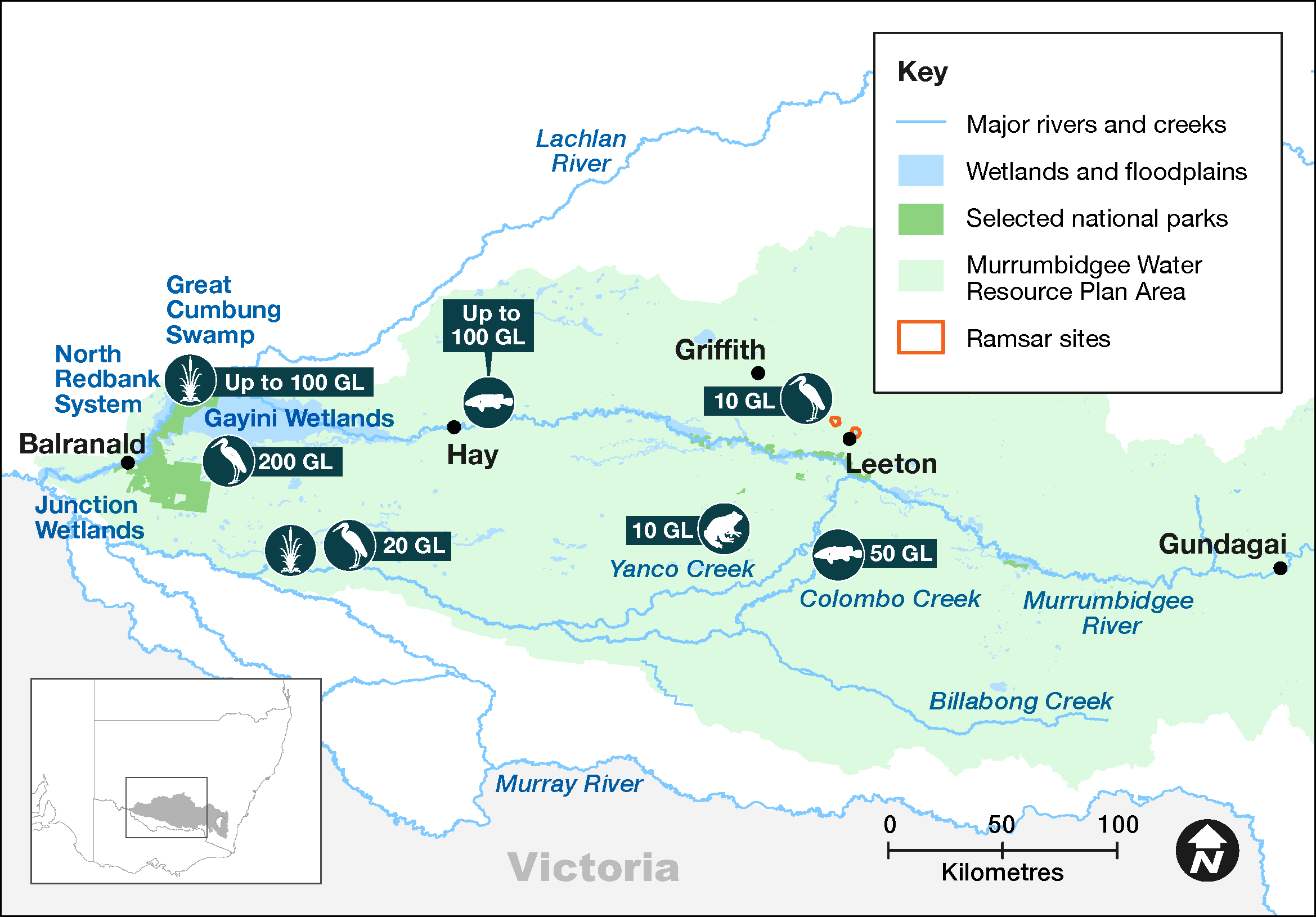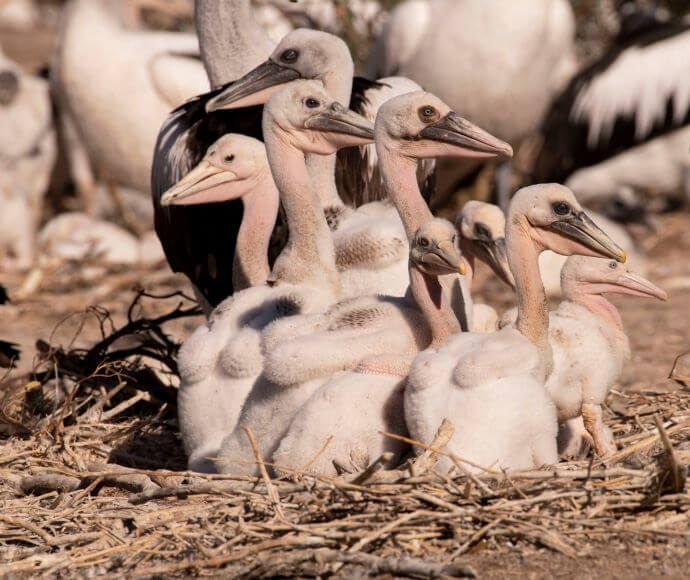Water that is allocated and managed specifically to improve the health of rivers, wetlands and floodplains is known as water for the environment.
NSW environmental water management teams work with local community advisory groups including landholders, Aboriginal stakeholders, partner agencies and other interested community members to develop detailed annual plans for the use of water for the environment in each catchment, including how its use is prioritised.
The catchment
The Murrumbidgee catchment covers 81,527 square kilometres and includes 26 storage or diversion structures, 1,690 kilometres of the river, and the surrounding wetlands. The climate conditions range from alpine in the Snowy Mountains to semi-arid on the Riverina plains.
Wetlands throughout the Murrumbidgee support threatened species listed under the Commonwealth Environment Protection and Biodiversity Conservation Act 1999 and NSW Biodiversity Conservation Act 2016.
The Murrumbidgee catchment is Country to the Barapa Barapa, Mutthi Mutthi, Nari Nari, Ngarigo, Ngunnawal, Wadi Wadi, Wolgalu, Wamba Wamba, Weki Weki and Wiradjuri Aboriginal people.
Water for rivers and wetlands
During 2022–23, the Department of Climate Change, Energy, the Environment and Water (the department) capitalised on very wet conditions across the catchment to deliver water for the environment to sites including the Gayini Wetlands and instream Murrumbidgee River.
Water was used to benefit wetland habitats in the Murrumbidgee and Coleambally irrigation areas as well as the Western Lakes, Forest Creek and Wanganella Swamp.
In 2023–24, managed watering events will initially focus on maintaining permanent water habitat for southern bell frogs, native fish, waterbirds and other aquatic species.
Water managers plan to supplement existing system flows to provide the maximum benefit to plants and animals. Watering events will aim to restore a more natural flow pattern to support a robust food web and other system functions.
Aboriginal water management priorities

Environmental water managers have been working to support Aboriginal people’s priorities in water management.
Water for Country is environmental water use planned by the department and Aboriginal people to achieve shared benefits for the environment and cultural places, values and/ or interests.
The department is partnering with the Nari Nari Aboriginal people to deliver dual environmental and cultural outcomes with water for the environment in the Gayini and Toogimbie wetlands system.
In 2023–24, we will continue to plan, in partnership with Mutthi Mutthi Aboriginal people, to enhance healthy Country outcomes, with a view to achieving longer term wetland and water management goals.
The department will be supporting the development of land and water management outcomes with Wiradjuri Aboriginal people, with a view to longer term co-management of numerous mid-Murrumbidgee environmental water assets.
Weather and water forecast
As at early June the El Niño–Southern Oscillation (ENSO1) outlook is neutral, with an El Niño watch. This will result in well below median rainfall for May to July 2023 for eastern mainland Australia, as forecast in the Bureau of Meteorology outlook issued in March 2023. The chance of exceeding median rainfall was stated as 20%.
Indicative starting allocations are 95% allocations for high security and 30% allocations for general security licences. Water management plans reflect these wetter conditions and are mindful of the favourable starting allocations and high carryover.
Water managers have prepared watering plans that consider a range of weather and water availability scenarios in case it rains more or less than expected. This is known as resource availability scenario planning. Moderate to wet conditions are forecast for the Murrumbidgee catchment in 2023–24.
1. ENSO: The interaction between the sea surface and atmosphere over the Pacific Ocean which results in dryer (El Nino) or wetter (La Nina) conditions.
Resource availability scenario
Current forecast: Moderate to wet
| Conditions | Main aim | Other aims |
|---|---|---|
| Very dry | Protect | Avoid critical loss Maintain key refuges Avoid catastrophic events |
| Dry | Maintain | Maintain river functioning Maintain key functions of high priority wetlands |
| Moderate | Recover | Improve ecological health and resilience Improve opportunities for plants and animals to breed, move and thrive |
| Wet to very wet | Enhance | Restore key floodplain and wetland linkages Enhance opportunities for plants and animals to breed, move and thrive |
Key planned actions for 2023–24
Waterbirds
Water managers have planned flows up to 200 gigalitres (GL) to provide foraging and breeding habitat for waterbirds, turtles, frogs and other aquatic species in areas including Gayini, Western Lakes and the North Redbank wetlands. Flows will water key Australasian bittern habitats in the Murrumbidgee and Coleambally irrigation areas.
Native fish
Water management plans allow for flows up to 200 GL to maintain instream and deep water off-stream habitats for native fish and to restore a more natural flow pattern to support native fish populations.
Water managers have planned trout cod and Murray cod nesting flows for the upper Yanco and mid-lower Murrumbidgee River systems. They may also undertake dispersal flows to allow young native fish and larvae to enter low lying floodplain habitat areas. Contingency water will be set aside to mitigate the risk of low flows heat wave/hypoxia in the lower Murrumbidgee weirs.
Vegetation
Water managers will provide up to 10 GL of water for the environment via pumping to key mid-Murrumbidgee and Yanco/Forest Creek sites currently out of reach of river flows, e.g. Willbriggie, Yarradda, Gooragool and Sunshower lagoons in the mid-Murrumbidgee, as well as Waldaira and Mainie swamps in the Junction Wetland system west of Balranald.
Connectivity
Water managers have planned flows to southern Yanga National Park via the Gayini wetland system and then south via Tala Lake (assuming reasonable starting allocations).
Map of proposed annual priority targets in the water resource plan area 2023–24

Map of proposed annual priority targets in the Murrumbidgee Water Resource Plan area 2023–24
The department is supporting the health and resilience of rivers and wetlands by delivering water for the environment where and when it is needed. We use the best available science, management expertise and experience to manage water across the landscape. This statement of annual priorities identifies the waterways and wetlands that are likely to receive water.
Our decision-making process considers:
- expected availability of water in the coming year
- conditions of the previous year
- current health of the plants and animals in these ecosystems.
About water for the environment
Water for the environment delivers benefits for communities, rivers, wetlands and wildlife across New South Wales.
Healthy, connected rivers and floodplains are a focus for tourism, fishing, recreation and relaxation. Rivers carry water to our homes, schools, farms and businesses, and along the way, support countless species including native fish, waterbirds, frogs, plants and more.
Rivers and wetlands have great cultural and spiritual significance for Aboriginal people.
Water for the environment is a critical tool to maintain and enhance the rivers, wetlands and wildlife we all love.
Working with communities
Local communities are at the heart of everything we do.
We involve the broader community by holding site tours and forums, and online and in-person events.
NSW water management teams consult regularly with community-based environmental water advisory groups.
Environmental water advisory groups members include local landholders, recreational fishers, Aboriginal people and local government representatives. Their advice helps to inform the decisions made by our local environmental water management teams.
Expected environmental water volumes available at 1 July 2023
The Department of Climate Change, Energy, the Environment and Water works with partner agencies to manage environmental water in the catchment.
Planned environmental water
| Source | Maximum volume available (gigalitres) | Volume expected 1 July under current conditions (gigalitres) |
|---|---|---|
| Environmental Water Allowance (1) | 100 GL Linked to announced general security allocations | 50 GL |
| Environmental Water Allowance (2) | Triggered by Burrinjuck Dam inflows and releases | 26 GL |
| Environmental Water Allowance (3) | Linked to announced general security allocations | 0 GL |
Water licenced to New South Wales
| Source | Maximum volume available (gigalitres) | Volume expected 1 July under current conditions (gigalitres) |
|---|---|---|
| General security | 31.4 GL | 7.85 GL new allocation, approx. 9.4 carryover |
| Supplementary | 6.7 GL | Dependent on surplus flows |
| Lowbidgee supplementary access licence (South Redbank/Yanga) | 148 GL | Dependent on surplus flows |
Water licenced to the Commonwealth
| Source | Maximum volume available (gigalitres) | Volume expected 1 July under current conditions (gigalitres) |
|---|---|---|
| High security | 14.2 GL | Up to 13.5 GL |
| General security | 286.5 GL | 167.8 GL |
| Conveyance | 50.3 GL | 37.7 GL |
| Supplementary | 22 GL | Dependent on surplus flows from unregulated tributaries |
| Lowbidgee supplementary | 406.6 GL | Dependent on surplus flows |
Notes: This is an indicative summary of expected volumes to be available. For further detail and information on available volumes you can contact the region via the Department of Climate Change, Energy, the Environment and Water on 1300 361 967.
1 gigalitre = 1000 megalitres; 2.5 megalitre = 1 Olympic swimming pool.
Outcomes of water for the environment
Water for the environment has been delivering outcomes for rivers, wetlands and wildlife for 30 years.
We deliver flows that:
- trigger native fish to breed and move
- support waterbirds to nest and feed
- connect rivers and floodplains
- water forests and floodplains
- allow plants to grow, flower and set seed
- create refuge during droughts
- enhance outcomes during wetter times
- release vital nutrients from the floodplain floor that underpin the aquatic food web.
It’s habitat restoration on a landscape scale.

Wet conditions help maintain habitat for waterbirds.
More information on planned and past watering events
- Annual environmental water priorities in the Murrumbidgee catchment 2022–23
- Murrumbidgee catchment – Water for the Environment: Annual Priorities 2021–22
- Murrumbidgee catchment: Annual environmental watering priorities 2020–21
- Murrumbidgee: Annual environmental watering priorities 2019–20
- Murrumbidgee catchment: Annual Environmental Watering Priorities 2018–19
- Murrumbidgee catchment: Annual environmental watering priorities 2017–18
- Murrumbidgee Water Resource Plan Area: Statement of annual environmental watering priorities 2016–17
- Murrumbidgee Water Resource Plan Area: Statement of annual environmental watering priorities 2015–16
- Vegetation Mapping Project: Executive summary – NSW Rivers Environmental Restoration Program
- Water for environment outcomes 2022–23
- Use of water for the environment in NSW: Outcomes 2020–21
- Use of water for the environment in NSW: Outcomes 2019–20
- Use of water for the environment in NSW: Outcomes 2018–19
- Use of water for the environment in NSW: Outcomes 2017–18